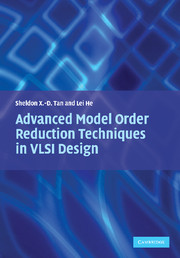Book contents
- Frontmatter
- Contents
- Figures
- Tables
- Foreword
- Acknowledgments
- 1 Introduction
- 2 Projection-based model order reduction algorithms
- 3 Truncated balanced realization methods for MOR
- 4 Passive balanced truncation of linear systems in descriptor form
- 5 Passive hierarchical model order reduction
- 6 Terminal reduction of linear dynamic circuits
- 7 Vector-potential equivalent circuit for inductance modeling
- 8 Structure-preserving model order reduction
- 9 Block structure-preserving reduction for RLCK circuits
- 10 Model optimization and passivity enforcement
- 11 General multi-port circuit realization
- 12 Reduction for multi-terminal interconnect circuits
- 13 Passive modeling by signal waveform shaping
- References
- Index
12 - Reduction for multi-terminal interconnect circuits
Published online by Cambridge University Press: 19 January 2010
- Frontmatter
- Contents
- Figures
- Tables
- Foreword
- Acknowledgments
- 1 Introduction
- 2 Projection-based model order reduction algorithms
- 3 Truncated balanced realization methods for MOR
- 4 Passive balanced truncation of linear systems in descriptor form
- 5 Passive hierarchical model order reduction
- 6 Terminal reduction of linear dynamic circuits
- 7 Vector-potential equivalent circuit for inductance modeling
- 8 Structure-preserving model order reduction
- 9 Block structure-preserving reduction for RLCK circuits
- 10 Model optimization and passivity enforcement
- 11 General multi-port circuit realization
- 12 Reduction for multi-terminal interconnect circuits
- 13 Passive modeling by signal waveform shaping
- References
- Index
Summary
In this chapter, we study the model order reductions on interconnect circuits with many terminals or ports. We show that projection-based model order reduction techniques are not very efficient for those circuits. We then present an efficient reduction method which combines projection-based MOR with a frequency domain fitting method to produce reduced models for interconnect circuits with large terminals.
Introduction
Krylov subspace projection methods have been widely used for model order reduction, owing to their efficiency and simplicity for implementation [32, 37, 85, 91, 113]. Chapter 2 has a detailed review of those methods.
One problem with the existing projection-based model order reduction techniques is that they are not efficient at reducing circuits with many ports. This is reflected in several aspects of the existing Krylov subspace algorithms like PRIMA [85]. First, the time complexity of PRIMA is proportional to the number of ports of the circuits as moments excited by every port need to be computed and matrix-valued transfer functions are generated. Second, the poles of the reduced models increase linearly with the number of ports, and this makes the reduced models much larger than necessary. The fundamental reason is that all the Krylov-based projection methods are working directly on the moments, which contain the information of both poles and residues for the corresponding transfer function.
- Type
- Chapter
- Information
- Advanced Model Order Reduction Techniques in VLSI Design , pp. 204 - 214Publisher: Cambridge University PressPrint publication year: 2007

